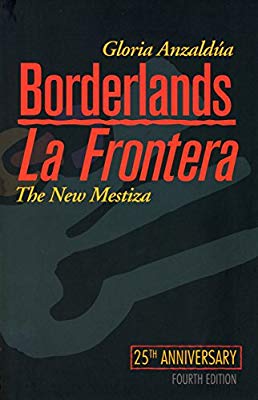In 1987, Gloria Anzaldúa, the Chicana feminist and queer theorist, published Borderlands [/] La Frontera [/] The New Mestiza, a collection of her essays spanning from 1980 to 1987. On its title page, ‘Borderlands’ appears above ‘La Frontera’: the two words bolded, and separated by a black, horizontal line, akin to the format of a fraction or formula. ‘Gloria Anzaldúa’ and ‘The New Mestiza’ float in the above and below margins, respectively, of the titular formula. This opening page visually introduces Anzaldúa’s theoretical mapping to be developed over the subsequent 200 pages. Taking the hybrid form of both poetry and prose, Borderlands mirrors Anzaldúa’s own hybrid identity, as a woman born in Harlingen, Texas, which is located less than 20 miles from the US/Mexican border.
The technical elements of Anzaldúa’s writing open up the possibilities of how we as readers can more fully understand her nuanced positioning of ‘the new mestiza.’ By technical elements I mean a focus on the strategies in Anzaldúa’s writing which exceed the actual content of the words on the page. I am most interested in thinking through her approach to text layout and indentations, italics and quotation marks, and, most importantly, to the mix of languages in which she writes, sometimes three in one single sentence. In her Preface to the book, Anzaldúa aptly prepares the reader for this multi-lingual engagement: “The switching of ‘codes’ in this book from English to Castillian Spanish to the North Mexican dialect to Tex-Mex to a sprinkling of Nahuatl to a mixture of all of these, reflects my language, a new language- the language of the Borderlands.” She positions this code-switching as a way to counter the bastardization of Chicano Spanish, a refusal to translate and alter her (Chicano) language for both English and Spanish speakers/readers. She ends the preface with an invitation to the reader: “This book is our invitation to you- from the new mestizas.” Earlier in the Preface, Anzaldúa writes ‘mestiza’ in italics. The new style treatment of ‘mestiza’ is a significant gesture to leave behind the apologies for being mestiza; a demand to transition mestiza out of the othering territory marked by the italics format, and into an equal and undistinguishable format, along with the English language. However, in other sections of the book, Anzaldúa will write ‘mestiza,’ or a variation of the word, in italics, depending on its context. In the case of the Preface, it does mark the beginning of a crucial demand for the word to exist as both italicized and in ‘regular text.’
Through a combination of a non-linear narrative style, and the mixing of historic literature, poetry, and her personal familial stories, Anzaldúa destabilizes any sense of hierarchy towards her own words. She distinguishes sources not only through traditional writing techniques like italics and quotation marks, but also through indented spaces, allowing for one source to flow into the next. Following two extracted quotes at the very beginning of the chapter, one by Los Tigres del Norte (which is written in Spanish and italicized), and the next by Jack D. Forbes, author of Aztecas del Norte: The Chicanos of Aztlán (which is bound by quotes), Anzaldúa positions a poem that relates the impact of the ocean and the coastline, to the treatment of those living in this borderland. The six lines of the first stanza of the poem are left aligned, and indented slightly right, from the quote above. As the poem continues, Anzaldúa stair steps the lines of each stanza, applying a different alignment treatment to each stanza, sometimes adding several spaces between sets of words in a single line. For example, in the fifth stanza. Anzaldúa writes:
I walk through the hole in the fence
to the other side.
Under my fingers I feel the gritty wire
rusted by 139 years
of the salty breath of the sea.
As we read, our eyes flow across the page, jumping from one margin to the next, attempting to negotiate the staggered structure of a poem in order to make sense of its meaning. Soon, we realize that what we are doing is reading a wave; specifically, a wave that is rolling into shore, crashing up against a border fence that was politically, historically, and economically unjustly imposed. The extra space Anzaldúa adds between ‘I walk,’ and ‘through the hole in the fence,’ serves as an anticipatory visualization of what is to come. We pause after ‘I walk,’ perhaps first wondering if the extra, unanticipated space is there by accident, but then only after completing the line can we respond to the prompt of the space.
Through these technical elements of text layout, Anzaldúa enacts her theoretical framework of a hybrid-borderland identity. The reader must be active in this sense, letting go of any expected ease of left-aligned, margin adjacent text. Because, we are not just reading text. We are also reading design, we are reading the spaces, the cracks, the holes between the words and the margins of the pages. We are reading the borderland. Only when we take in the page as a whole, can we appreciate Anzaldúa’s narrative and conceptual imaging.
-Written by Thea Spittle, LAB Curatorial Fellow
